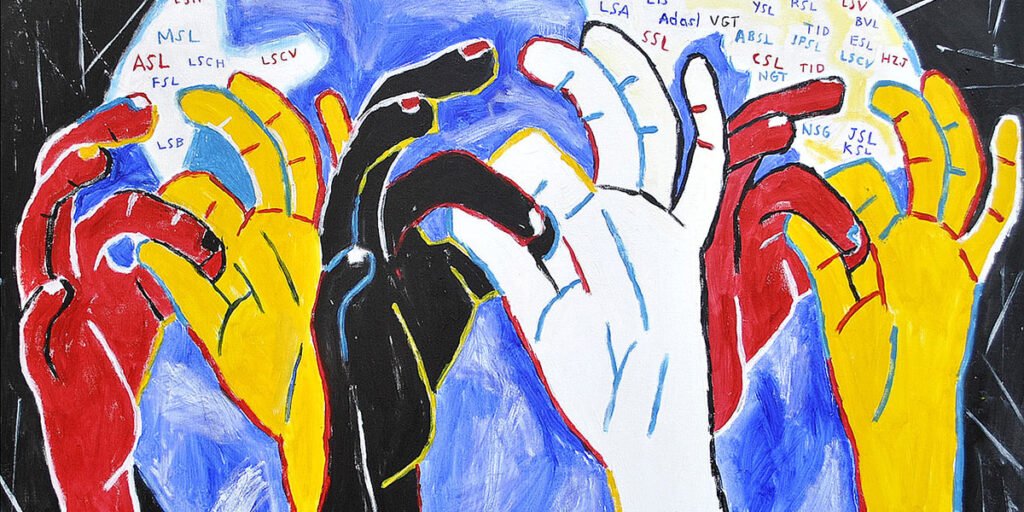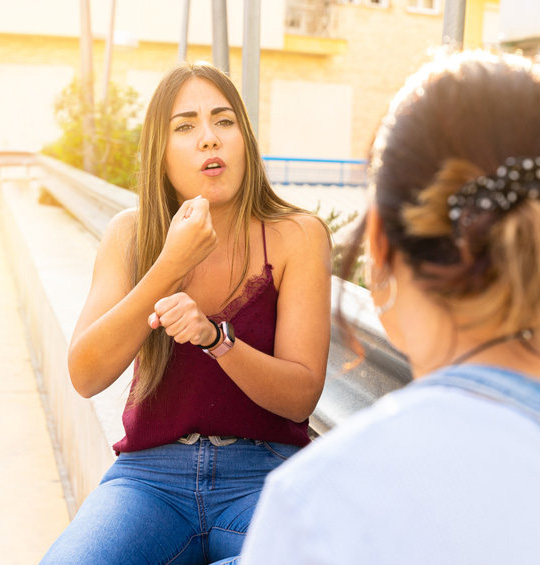Think for a moment. Do you know someone who is deaf? Or is someone close to you deaf or hard of hearing? If yes, can you easily communicate with that person? If not, do one or both of you get frustrated?
Deafness is a significantly misunderstood “ability” that has major life effects for those on those with hearing loss. These effects include:
- Fewer educational and job opportunities
- Social withdrawal because of the inability to communicate with others
- Emotional issues because of low self-esteem and little confidence

By the Numbers
In the United States today, around 600,000 people or 22 percent of the population, has some degree of hearing loss, and of this, more than half are aged 65 and older. However, among deaf people, who are aged 18 to 44, just 58 percent are in the workforce, compared to a total 82 percent of hearing people.
In addition, 12.8 percent of hearing people acquired a college degree compared to 5.1 percent of dear or hard of hearing people.
Although age related deafness is growing exponentially, there is a large group of people whose deafness is not, and for the most part, they were either born deaf or became what is called “late-deafened,” which means they became deaf later in life due to an illness or accident.
Deaf or deaf?
But among those with a hearing loss, there is deaf and there is Deaf. Not everyone admits to or embraces their deafness, and these individuals are what is referred to as “deaf”. They consider that they have a medical or age-related hearing issue and that’s that.
On the other hand, there are the “Deaf,” who have developed and live in a fascinating and rich culture. Through its art, literature, religious institutions, and history, Deaf culture has become a unique way of celebrating everything about their deaf experience with other deaf people.
If you look at the figures for employment and education, and these are just two statistics that represent the difficulty of functioning as a deaf person in a hearing world, it explains why they would share their experiences and support one another.
Schools as the Beginning of Deaf Culture
Back in the late nineteenth and early twentieth centuries, it was common for children who were labeled “different” to be housed in poor, asylum-like conditions where love and caring were hard to come by. This included deaf children who were also seen to be different, and many of whom ended up in these terrible institutions.
Eventually, schools just for deaf children developed. These schools did not use the same, or similar academic methods for communication as other schools. However, some schools for deaf children insisted on using oral communication while others developed systems of signs. Those residential schools for deaf children, especially the ones who used a form of communication using signs, fostered Deaf Culture and encouraged its richness of custom and communication.
The Birth of A Community
But the real key to the beginning of Deaf culture were these schools that used only sign language and that argued that deaf children must become part of a supportive deaf community. These schools ended up developing networks of deaf families that formed connections and gleaned support from one another. As they began to collect in groups, they also developed a new kind of language comprised of hand signs, facial expressions, and body language. The development of this language was a pivotal point in the history of Deaf culture.
Despite the success of this sign-based and supportive approach, another set of schools insisted that oral communication was necessary for students to function in the hearing world.
Isolation or Connection?
Some people say Deaf culture is isolationist. But is this a bad thing? No, because the number of people in the hearing world who can speak ASL is minimal. Can you imagine the frustration of not being able to communicate with someone who doesn’t know your language? And the impact on self-esteem? It is precisely this that urges many deaf people to become part of Deaf culture.
At the core of the Deaf culture is American Sign Language, or ASL for short. ASL is not the same thing as English sign language, which approaches a direct translation of English into signs. On the contrary, ASL does not use the grammar and mechanical conventions of standard English at all. It is a beautiful language where the hands dance and the face brightens with expression.
ASL was not recognized as an official language until the 1960s, and this became a major victory for the Deaf culturists. As the years went by, so did the strength of the culture.
CODA Kids
Not all deaf parents have deaf kids, and not all deaf kids have deaf parents. Children who have deaf parents are referred to as CODA – Child of Deaf Adults. Interestingly, not many deaf people are born into deaf families. This makes their assimilation into Deaf culture more difficult for them. However, parents of deaf people, and others such as interpreters are welcome to participate in the culture by using ASL and embracing other aspects of the culture.
Gallaudet University
The formation of a deaf institute of higher education that embraces Deaf culture is no surprise. What is a surprise is that in 1864, President Abraham Lincoln signed the charter that marked Gallaudet University as a school for deaf and hard of hearing students. Today the university offers 40 majors leading to either a Bachelor of Arts or Bachelor of Science degree. It also offers graduate programs in a variety of disciplines.
An impressive 94 percent of the courses have some kind of technology component, and some are offered entirely online. The school is also committed to research that addresses deaf and hard of hearing issues, conducted through Gallaudet Research Institute. In the fall of 2022, 1558 students were enrolled with 1,055 in undergraduate and graduate programs.
Presidents and Deaf Culture
It was early March 1988, and on the seemingly serene Gallaudet campus, which is in a Washington, D. C. suburb, that perception of serenity was about to be shattered. In the previous year, then college president and hearing person, Jerry C. Lee resigned his post. Students were excited and believed this was the time to elect one of their own – a deaf president. To announce their belief, they mounted a campus-wide protest accompanied by tons of buttons and fliers, all financed by a single college alumnus.
In addition, during the first week in March 1988, the Board of Trustees of the college met and decided upon three candidates for the position: Elisabeth Zinser from the University of North Carolina at Greensboro and not deaf; I. King Jordan, a then dean at the college who became deaf at 21; and Harvey Corson, president of a Louisiana deaf school and deaf from birth.
Zinser, who is hearing and did not know sign language, was selected and the students “took over” the school by locking the campus gates with hefty chains, slashing supporters’ tires, and erecting a “tent city” where supporters and students kept vigil. Effigies of Zinser lit the night campus skies and students refused to leave campus for spring break. Their demands were absolute:
- Force Zinser’s resignation
- Elect a deaf president
- Insist on the resignation of the board chair who was heard as saying that deaf people were not prepared yet to function in the hearing world.
- Revamp the board of trustees from 4 deaf and 17 hearing members to affect a 50/50 split
- Guarantee no disciplinary actions against any students or other protestors
Not long after the protest, Zinser decided to resign and Dr. Jordan became and served as president of Gallaudet from 1988 to 2006.
As of 2024, the 11th and current president of Gallaudet, Roberta Cordano, is its first deaf woman.
And Finally…
It’s clear that our country’s Deaf individuals face many struggles that we hearing people never consider. These struggles have resulted in a culture that would be enriching to all people with its enthusiasm and beautiful language. Sometime, try attending a Deaf culture event – a play, a dance, or even a lecture, and marvel at the silent room punctuated by movement and dancing fingers.
Share this post with your friends using these one-click sharing options:
👉 Click here to share on Facebook.
👉 Click here to share on Twitter.
👉 Click here to share on LinkedIn.

Get the latest interviews, tips and guides in your inbox.